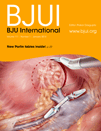What prophylactic steps should we take to prevent DVT/PE after RARP?
Deep vein thromboses (DVT) and pulmonary embolism (PE) are rare, but potentially devastating, complications of major pelvic surgery. We have performed more than 1000 robot assisted radical prostatectomy (RARP) procedures in Central London (Lessons learned from 1000 RARP operations BJUI 2013;111(1):9-10.) and to date encountered just a couple of DVTs, as well as a single, non-fatal instance of PE. However, in the case of one of us (RK), a close relative passed away as a result of a PE 10 days after a routine hip replacement performed in Oxford, a very sad event which highlighted the very negative impact on the family of this preventable surgical complication.
Guidance from NICE recommends that evidence-based steps be taken to reduce the risk of venous thromboembolism (VTE). Failure to do so therefore renders us open to criticism if a DVT, or worse a PE, does develop. On the other hand, pelvic haematoma and haematuria are troublesome complications of RARP, the risks of which may be exacerbated by anticoagulation.
What therefore should we be doing to reduce the risk of before and after laparoscopic pelvic surgery? Few would disagree that TED stockings should be worn before and after surgery, but how long should they be retained, as many patients do find them rather uncomfortable? Calf compression boots during surgery and for 12 hours or so post-operatively should also be standard practice.
More contentious is the duration of use of low molecular weight heparin (LMWH). Some surgeons use a single dose immediately prior to the operation; we have used 5000 Units of Clexane post-operatively for 2-3 days. Orthopaedic surgeons are increasingly continuing LMWH for 28 days at home after joint replacement surgery, which carries a significant risk of VTE. Should we follow their lead? A simpler alternative from the patients’ viewpoint is daily use of one of the new oral anti-coagulants such as dabigatran.
 Perhaps the most sensible approach clinically is to perform a risk assessment of all RALP candidates pre-operatively. A calf compression device and TED stockings should be used for all patients, together with LMWH, while in hospital. Those considered especially at risk with, for example, a BMI >30 (Becattini CA) (See Box 1), should usually go home for a month with either LMWH injections or daily oral dabigatran, or equivalent oral anticoagulant agent.
Perhaps the most sensible approach clinically is to perform a risk assessment of all RALP candidates pre-operatively. A calf compression device and TED stockings should be used for all patients, together with LMWH, while in hospital. Those considered especially at risk with, for example, a BMI >30 (Becattini CA) (See Box 1), should usually go home for a month with either LMWH injections or daily oral dabigatran, or equivalent oral anticoagulant agent.
We would be most interested in the views, experiences and current practice of the readers of this piece. Please do post your own response.
Roger Kirby, Ben Challacombe and Prokar Dasgupta
The Prostate Centre, London W1G 8GT and Guy’s Hospital, King’s College London, King’s Health Partners
Comments on this blog are now closed.





Interesting blog!
At our centre, we re-visited the thromboprophylaxis measures after the publication of the NICE guidance. As rightly suggested, some centres do prescribe LMWH for 28 days after radical prostatectomy. This is in accordance to NICE guidelines that specifically mentions “if major cancer surgery in the abdomen or pelvis” is performed, then to “Continue LMWH (or UFH15) for 28 days after surgery”. Details of this recommendation can be found on page 16 of the NICE guideline (https://www.nice.org.uk/nicemedia/pdf/CG92QuickRefGuide%20LR%20FINAL.pdf). Therefore, will we be exposing ourselves medico-legally if we do not prescribe LMWH for 28 days? Although one can argue that patients undergoing Robotic-assisted Radical Prostatectomy are ambulatory the very same day and whether it is really required to provide them with 28 days of thromboprophylaxis. A recent study (https://www.ncbi.nlm.nih.gov/pubmed/23021972) “Thromboembolic events following surgery for prostate cancer” suggested that the largest risk was observed from days 14 to 28 postoperatively. Another previously reported study on radical prostatectomy (https://www.ncbi.nlm.nih.gov/pubmed/19143928) also suggested that the highest incidence of PE occurred between days 8 – 21. These results, similar to the NICE guidelines strongly suggest that prophylactic measures is needed during the first 4 weeks after the operation.
There was a paper published (https://www.ncbi.nlm.nih.gov/pubmed/15264246) in 2004 on a survey carried out titled “Thromboprophylaxis for radical prostatectomy: a comparative analysis of present practice between the USA, the UK, and Ireland”. Their results surprisingly revealed that only 24% of American Urologists used pharmacological thromboprophylaxis in contrast to 100% of British Urologists. Of course, this survey was carried before the publication of the NICE guidance and at a time wherein not many centres within the UK performing RARP. We have recently initiated a survey of UK urologists and will hopefully present the data in the future on the current practice pattern of thromboprophylaxis.
With Warm Regards,
Amrith Raj Rao
Great blog Roger. I think this NICE guidance is badly flawed and does not fully account for the very low incidence of VTE in the era of minimally-invasive radical prostatectomy (MIRP). Secin et al reviewed almost 6000 MIRP in Eur Urol (https://www.europeanurology.com/article/S0302-2838(07)00756-7/abstract) and reported a symptomatic DVT rate of only 0.5%. They concluded that routine use of heparin was not necessary except in those patients at high-risk.
I am quite tired of pharma representatives harassing me with the NICE guidance and I bat them away with Fernando’s paper. It appears that your view is the risk of VTE is very low based on your large experience of robotic radical prostatectomy and that 28 day prophylaxis is unnecessary. However practicing in the UK, the NICE guidance must be a nuisance. I don’t believe that it reflects the true risk in contemporary MIRP series. Here in the former colony I will be happily ignoring it.
Controversial topic.
Some patients are happy to inject low molecular weight heparin , others not so.
It would be useful to know what colleagues outside UK are doing in this regard.
Prokar
Interesting topic. We do not use stockings or calf compression devices. We only give LMWH during hospitalisation, so only for 1-3 days. In our series we have a symptomatic DVT rate of 0,25%
Carl Wijburg
Arnhem
Netherlands
@roboturoloog
At Guy’s, London we are somewhat forced to use TEDS and LMW Heparin for 28 days.
This involves considerable effort and pt education by the nurses. I would probably reserve it for at risk pts including high BMI and lymphadenectomy if i could. We have had no DVT/PEs since then but several haematomas!
The initial debate about thromboprophylaxis during open radical prostatectomy (ORP) was whether it was essential at all or not. Dr Catalona, one of the earliest proponents of ORP discontinued the use of thromboprophylaxis way back in the early 90s (https://www.ncbi.nlm.nih.gov/pubmed/1557840). Indeed, at AUA 2010, he presented a series of 1471 ORPs, wherein 99% of the patients did not receive any pharmacological thromboprophylaxis and concluded that sequential compression device stockings and early ambulation will be successful for the prevention of VTE in the great majority of patients, and that the rate of VTE following RRP is exceedingly low (0.5% DVT and 0.2% PE), suggesting that a less aggressive prophylactic strategy yields acceptable outcomes (https://www.jurology.com/article/S0022-5347(10)01857-4/fulltext). Recently, this has been supported by a multi-institutional analysis of nearly 6000 patients undergoing minimally invasive radical prostatectomy (https://www.ncbi.nlm.nih.gov/pubmed/17597288). The risk of symptomatic VTE was 0.5% only with only 2 patients dying due to PE. They concluded that the administration of prophylactic heparin to all patients undergoing LRP is not justified, especially those without risk factors for VTE.
Contrary to the above series, you can find several papers showing the benefit of pharmacological thromboprophylaxis after radical prostatectomy. No RCTs could be found but given the fact that there is 0.5% incidence of DVT, a trial with 80% power to detect a relative risk of 0.75 would require approximately 100,000 patients (https://www.ncbi.nlm.nih.gov/pubmed/17597288).
However, there are three important considerations to be taken into account.
1. The underestimation of DVT and/or PE by the operating surgeon after discharge of his patients.
A study by Swan et al on re-admissions due to DVT suggested that nearly 70% were admitted under a different specialty and astonishingly less than half the operating surgeons documented the re-admission due to DVT/PE. They conclude, to quote “The rate of DVT/PE complications following surgery is underestimated. This may lead to a reduced emphasis in DVT/PE prophylaxis in the mistaken belief that DVT/PE frequency is rarer than it is. Improved communication between teams is necessary to improve care.” https://www.ncbi.nlm.nih.gov/pubmed/14656231
In another audit by Brinsden et al, from Plymouth, UK also revealed that the operating surgeon was unaware of 87% of cases of pulmonary embolism and 20% of cases of deep vein thrombosis affecting patients in their post-operative period. https://www.ncbi.nlm.nih.gov/pubmed/12500486
This would be more so in the current era wherein patients travel to ‘centres of excellence’ for their operation. The operating surgeon assumes that if they ‘have not heard anything’ from the referring physician, then ‘everything is fine’.
2. The under-estimation of asymptomatic DVT
An elegant study by Beyer et al, shed some light on asymptomatic DVT in patients undergoing radical prostatectomy. They prospectively assessed for DVT by complete compression ultrasound at days -1, +8 and +21. They found an alarming rate of 16.8% VTE events, most being asymptomatic DVT in the calf veins!
3. Although the incidence of symptomatic VTE and mortality is low, it is preventable!
Often, physicians become the ‘slaves of statistics’, i.e., the risk of death from a fatal PE is low, less than 1%. However, as Prof Kirby has personally experienced, when this ‘statics’ is someone close to you, these numbers turn into reality! The matter in question is whether the benefits outweigh the risks to recommend routine administration to all patients. Again the review of literature focusing on radical prostatectomy is split with some studies suggesting higher risk of bleeding and lymphcoele (which itself is a risk factor for proximal DVT!), while other studies showing no difference in complications. As mentioned above, carrying out a RCT is not practically feasible when the given event is estimated to be low.
The debate will rage on for some time to come. Ultimately, each unit will adopt their own policy that usually reflects their personal experience with VTE in their cohort undergoing radical prostatectomy.
Some interesting insights into patterns of VTE prophylaxis utilization among AUA members: https://www.ncbi.nlm.nih.gov/pubmed/23538239